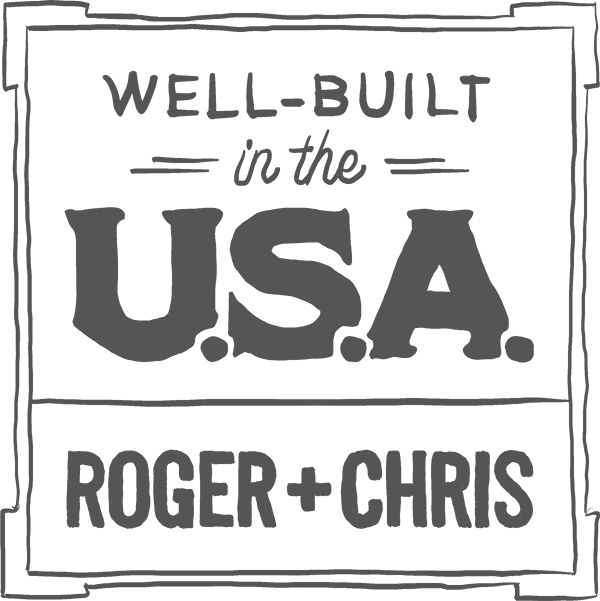Frequently Asked Questions
Can you build me a chemical-free sofa?
All Topics | Sofa Options
Literally everything in our universe is comprised of chemicals, including sofas. We're going to need you to be a bit more specific in your request. 😉
Most folks who come to us with questions about "chemical-free" sofas are ultimately asking about:
- Flame retardants, some of which have been shown to be carcinogens
- Stain protection agents, some of which have been shown to be harmful to humans
- Formaldehyde, which is a chemical of concern for many
- Off-gassing of new materials, which can be problematic for some individuals
- Petrochemicals, which some customers wish to minimize in their home
We're confident that we are one of the "cleanest" and most responsible manufacturers of upholstery operating in the United States. We strive to make prudent choices about the materials used in our products and openly disclose which materials are present in the furniture you purchase from us. Here is our best attempt to provide clarity on the above listed areas of concern. Please note — and this is important — that we cannot speak conclusively for every vendor supplying materials to us and cannot guarantee with certainty that your furniture will not be exposed to or, to a lesser degree, contain chemicals you object to. This is a wide-ranging subject matter and we understand that some individuals have severe sensitivities to certain materials. In such a scenario, we recommend first speaking with us.
Flame retardants: We were one of the first furniture manufacturers to remove unnecessary and potentially carcinogenic flame retardants from the foam in our cushions. Our sleeper sofa mattresses are also free of these retardants. While we are required by law to use fabrics, leathers, and other materials that meet or exceed standards for burn and smolder resistance, these materials generally achieve this without reliance upon added retardants.
Stain protection: Many of our fabrics are performance products that have been treated with stain resistance products. There are, broadly speaking, four categories of stain resistance. Here is a bit of information on them.
- No applied stain protection. Pretty straight-forward, there. Just a fabric with no protection at all on it.
- Spray-on stain protection. Widely referred to by the brand name Scotchgard™, spray-on stain protection is exactly what it sounds like. The original generation of these products relied on an 8-chain carbon molecule in the coating. Studies showed that these molecules were a potential cause of concern, with these long molecules lingering in the human body for an undesirable length of time. Later generations of spray-on protection utilized 6- and 4-chain molecules. These provide a lesser level of protection and have a reduced level of durability, but are far more rapidly eliminated from the body and thus are believed to pose less of a risk. 4-chain molecules are generally not durable enough for upholstery fabric applications, so fabric with this form of protection will most likely use 6-chain formulas.
- Bake-on stain protection. Superior in every way to spray-on, bake-on protection — widely known by the brand name Crypton but available through a number of vendors — is the form used on our most popular performance fabrics and is a well-proven option. The method of application is unique, with the finished fabric being "dipped" into the protection solution which is then "baked" into the fabric. Beyond providing an excellent level of stain resistance, this greatly reduces the risk of off-gassing. The solution used in this process is biodegradable, is not considered a carcinogen by NTP, IARC, or OSHA, and is not expected to bioaccumulate.
- Solution-dyed fabric. For those seeking excellent stain resistance and UV fade resistance without the use of applied treatments, solution-dyed fabric is your friend. We describe solution-dyed fabric elsewhere on this page, but the big takeaway is that, due to the method of manufacture, these products delivery great performance without anything else getting added to the mix. They also tend to be the most highly-awarded products in terms of Greenguard and Cradle-to-Cradle certification.
Formaldehyde: Many of our customers want to minimize or eliminate exposure to formaldehyde in their homes. In the context of sofas, the biggest vector for formaldehyde introduction is through the plywood used in most companies' sofa frames. Because the vast majority of our furniture is built without any plywood, our products are far ahead of the curve. Note that a few of our non-sofa frames, such as ottomans, utilize plywood to create round shapes, etc. We use it sparingly and exposure should be minimal.
Off-gassing: Beyond formaldehyde, some customers do express concerns regarding off-gassing of new materials brought into their home. Our furniture sparingly utilizes adhesives and varnishes in the manufacturing process. These are all low- or zero-VOC products. Solution-dyed fabrics typically perform better than other materials in terms of off-gassing.
Petrochemicals: The foam in our seat cushions, as with the vast majority of upholstery products on the market, is petroleum-based. We utilize high-quality, domestically-sourced foam for our furniture. Should you prefer an alternative, we can build your sofa using natural latex foam. Note that performance and longevity of this product is not something we can guarantee and that the material carries a substantial upcharge. But we can certainly do it.
Direct link to this page: https://www.rogerandchris.com/faq/question/can-you-build-me-a-chemical-free-sofa-31

